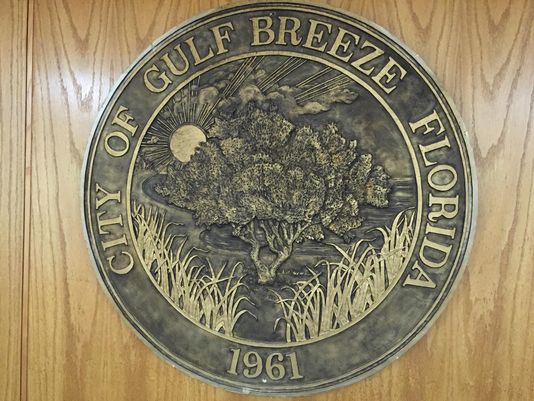
This past weekend, City of Gulf Breeze Mayor Matt Dannheisser was making his monthly trip to Deadman’s Island and was shocked at what he witnessed.
“I’ve been out there on a monthly basis for years and I could not believe what I saw. There is about 100 feet of isthmus under water,” he said. “So there is direct flow from the bay into the bayou—and I don’t know what the ecologic effects are on the island and on the estuary is—but, it’s not just a small bridge. It’s a massive bridge.”
A bridge threatening to swallow the small island often treaded on by visitors and locals alike.
Dannheisser raised concern at Monday’s city council meeting about the future of the island. Recently, the city formed a committee to address issues with the strip of land. But Dannheisser said what he witnessed last weekend was an “emergency situation” in his eyes.
“I am wondering if we should look into whether emergency action is warranted,” Dannheisser said. “I don’t know, maybe I’m overreacting. Maybe it’s a temporary type thing, and on the other hand, maybe it’s far more serious.”
The mayor suggested having their environmental consultant look at the present condition of the land and determine whether the rising water will have an adverse or permanent affect on the treasured land.
“(We should) look to see if our environmental consultant should evaluate it immediately. Not weeks or months. And report to staff in the next few days to see if action needs to be taken,” he told council members.
One of the many concerns brought up by the Deadman’s Island Committee is the impact the new Pensacola Bay Bridge Project could have on the future of the land.
Gulf Breeze resident and Deadman’s Island committee member Robert Turpin told the council that what’s happening to the land now is similar to what happened when the current bay bridge was built decades ago.
“If you go back and look at the historic aerials of Gilmore, it was a lake before we opened it up and made the channel on the southwest side. Twice in the 1940s and early 1950s it’s breached before. So it’s breached and healed itself,” Turpin said. “The difference between then and now is that in 1930 when the new bridge was built, essentially the tap was shut off for any renourishment sediment. The real issue there is the sea level is rising. And since the bridge was constructed, the sea level has risen 7 inches.”
The rising water has essentially swallowed part of the island, and the council was concerned whether the new bay bridge project would all but eliminate the strip of land.
Both Dannheisser and Turpin agreed that something had to be done immediately.
“You have a diminished sediment supply and there’s only really one way to maintain the isthmus, and that is to renourish that sediment budget…because it’s not happening naturally. You’d have to come in and do a beach renourishment,” Turpin said. “And that wouldn’t happen overnight.”
The council discussed doing an emergency renourishment of the island, which they could essentially do through the Department of Environmental Protection. But emergency permits would have to be pulled in order to get the project going within the next several months—before the Pensacola Bay Bridge Project officially starts.
“To me the first question is, ‘How emergent is this situation?’. Then, ‘What do we do?’ I’m talking about tomorrow, Wednesday,” Dannheisser said Monday evening. “I’m concerned that we have an emergency situation. And I know that there are abilities through DEP to have emergency restoration efforts done. And if we have the spoils already existing nearby, that can be done on an expedited basis. But there is a vehicle to get a expedited permit and that can be done in 60 days.”
But first, Dannheisser said the city needs to bring in an expert to determine how serious the issue really is before considering emergency renourishment.
“We need to have someone come in there and look and say ‘Should we be taking action?’ and ‘What are the consequences if we don’t act now?’” Dannheisser said. “Those of you who have not seen it, you need to go. It was shocking to me. I’ve been out there on a monthly basis for years and I could not believe what I saw.”
For now, the city will look to its environmental consultant to determine its next steps to protect the piece of land from being breached completely.
“We have to ask ourselves, ‘What do we want to invest in the land form out there?’” Turpin said. “Leaving those historic resources out there, even if we were to do a great project like (Project) GreenShores, those resources would still be at risk to tropical storms and hurricanes. So I wouldn’t want to favor any type of recommendation to say those resources are protected out there. I don’t think anything we do on that island out there will protect those resources. The factor that has had the most effect on Deadman’s Island was the bridge that was built (decades ago).”
































